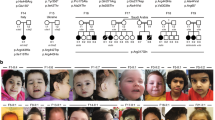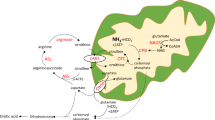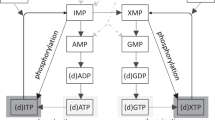Abstract
The high metabolic requirements of the mammalian central nervous system require specialized structures for the facilitated transport of nutrients across the blood-brain barrier. Stereo-specific high-capacity carriers, including those that recognize glucose, are key components of this barrier, which also protects the brain against noxious substances. Facilitated glucose transport in vertebrates is catalyzed by a family of carriers consisting of at least five functional isoforms with distinct tissue distributions, subcellular localizations and transport kinetics1,2. Several of these transporters are expressed in the mammalian brain3. GLUT-1, whose sequence was originally deduced from cDNAs cloned from human hepatoma and rat brain4,5, is present at high levels in primate erythrocytes and brain endothelial cells. GLUT1 has been cloned and positionally mapped to the short arm of chromosome 1 (1p35-p31.3; refs 6–8). Despite substantial metabolic requirements of the central nervous system, no genetic disease caused by dysfunctional blood-brain barrier transport has been identified. Several years ago, we described two patients with infantile seizures, delayed development and acquired microcephaly who have normal circulating blood glucose, low-to-normal cerebrospinal fluid (CSF) lactate, but persistent hypoglycorrachia (low CSF glucose) and diminished transport of hexose into isolated red blood cells (RBC; ref. 9). These symptoms suggested the existence of a defect in glucose transport across the blood brain barrier. We now report two distinct classes of mutations as the molecular basis for the functional defect of glucose transport: hemizygos-ity of GLUT1 and nonsense mutations resulting in truncation of the GLUT-1 protein.
This is a preview of subscription content, access via your institution
Access options
Subscribe to this journal
Receive 12 print issues and online access
$209.00 per year
only $17.42 per issue
Buy this article
- Purchase on Springer Link
- Instant access to full article PDF
Prices may be subject to local taxes which are calculated during checkout
Similar content being viewed by others
References
Mueckler, M. Facilitative glucose transporters. Eur. J. Biochem. 219, 713–725 (1994).
James, D.E. The mammalian facilitative glucose transporter family. News Physiol. Sci. 10, 67–71 (1995).
Maher, F., Vannucci, S. & Simpson, I. Glucose transporter proteins in brain. FASEB J. 8, 1003–1011 (1994).
Mueckler, M. et al. Sequence and structure of a human glucose transporter. Science 229, 941–945 (1985).
Birnbaum, M.J., Haspel, H.C. & Rosen, O.M. Cloning and characterization of a cDNA encoding the rat brain glucose-transporter protein. Proc. Natl. Acad. Sci. USA 83, 5784–5788 (1986).
Shows, T. et al. Polymorphic human glucose transporter gene (GLUT) is on chromosome 1p31.3–p35. Diabetes 36, 546–549 (1987).
Williams, S.A. & Birnbaum, M.J. The rat facilitated glucose transporter gene. Transformation and serum-stimulated transcription initiate from identical sites. J. Biol. Chem. 263, 19513–19518 (1988).
Fukumoto, H., Seino, S., Imura, H., Seino, Y. & Bell, G.I. Characterization and expression of human HepG2/erythrocyte glucose-transporter gene. Diabetes 37, 657–661 (1988).
De Vivo, D. et al. Defective glucose transport across the blood-brain barrier as a cause of persistent hypoglycorrhachia, seizures, and developmental delay. N. Engl. J. Med. 325, 703–709 (1991).
Hiraki, Y., Rosen, O.M. & Birnbaum, M.J. Growth factors rapidly induce expression of the glucose transporter gene. J. Biol. Chem. 263, 13655–13662 (1988).
Allard, W.J. & Lienhard, G.E. Monoclonal antibodies to the glucose transporter from human erythrocytes. J. Biol. Chem. 260, 8668–8675 (1985).
Davies, A., Meeran, K., Cairns, M.T. & Baldwin, S.A. Peptide-specific antibodies as probes of the orientation of the glucose transporter in the human erythrocyte membrane. J. Biol. Chem. 262, 9347–9352 (1987).
De Vivo, D.C., Garcia-Alvarez, M., Ronen, G. & Trifiletti, R. Glucose transport deficience: an emerging syndrome with therapeutic implications. Inter. Pediatrics 10, 51–56 (1995).
Oka, Y. et al. C-terminal truncated glucose transporter is locked into an inward facing form without transport activity. Nature 345, 550–553 (1990).
Santer, R., et al. Mutations in GLUT2, the gene for the liver-type glucose transporter, in patients with Fanconi-Bickel Syndrome. Nature Genet. 17, 324–326 (1997).
Garcia de Herreros, A. & Birnbaum, M.J. The acquisition of increased insulin-responsive glucose transport in 3T3-LI adipocytes correlates with expression of a novel transporter gene. J. Biol. Chem. 264, 19994–19999 (1989).
Price, E.R. et al. Human cyclophilin B: a second cyclophilin gene encodes a peptidyl-prolyl isomerase with a signal sequence. Proc. Natl. Acad. Sci. USA 88, 1903–1907 (1991).
Author information
Authors and Affiliations
Corresponding author
Rights and permissions
About this article
Cite this article
Seidner, G., Alvarez, M., Yeh, JI. et al. GLUT-1 deficiency syndrome caused by haploinsufficiency of the blood-brain barrier hexose carrier. Nat Genet 18, 188–191 (1998). https://doi.org/10.1038/ng0298-188
Received:
Accepted:
Issue Date:
DOI: https://doi.org/10.1038/ng0298-188



